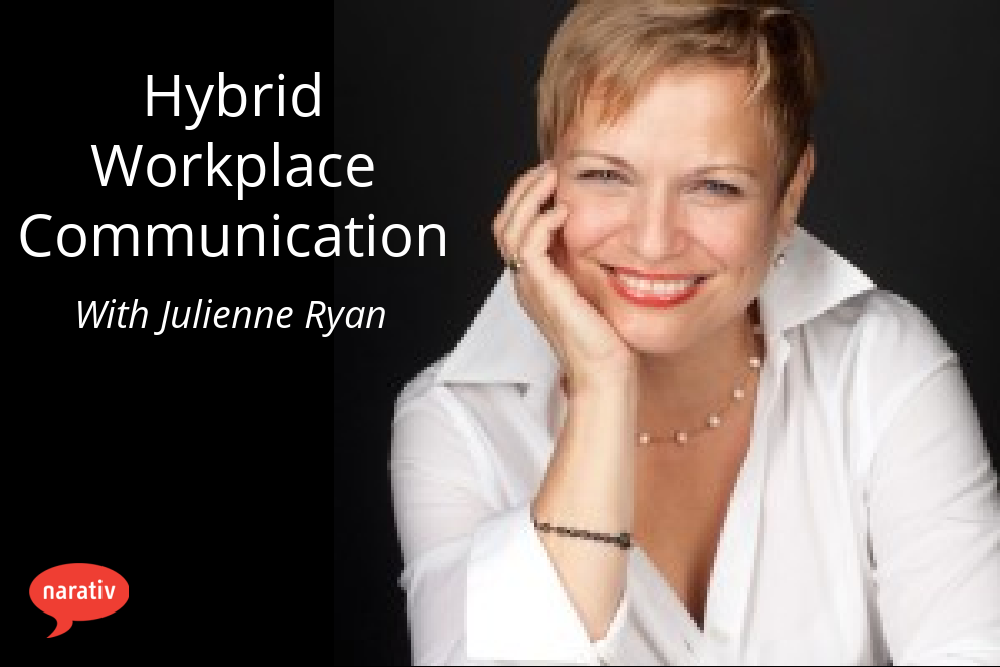Thoughts from Communication Catalyst, Julienne Ryan
With the rollercoaster that’s been the last few years, hybrid workplace communication (or our lack of it) has become a hot topic to say the least. We’ve seen more of our colleagues’ living situations than ever before, there are entire research studies exploring how organizations should best navigate the challenges of poor communication in the workplace that arise from hybrid work situations, and yet it seems that—more than ever—many people are still left wondering how to best connect and communicate with others.
This is why Narativ took a few minutes to sit down with Julienne B. Ryan, our Training Consultant who specializes in HR. Julienne is a communication catalyst. With a background as a talent management professional, educator, performer, and consultant, she focuses on helping both individuals and organizations develop real connections through the power of story and real communication at work. Her voice is a guiding light as we all grapple with the workplace communication challenges we’re collectively facing. Here’s our conversation with Julienne.
What types of organizations do you work with?
Julienne Ryan: My client list is pretty varied. I’ve had clients who are universities, associations, leadership-focused non-profits, corporations, and I also do quite a bit of work in consulting and leadership.
You are a speaker, author, coach, facilitator—and that’s only part of the list—and you refer to yourself as a “communications catalyst.” Tell us more about your story and what being a communications catalyst looks like in your day-to-day.
JR: Technically, I teach applied storytelling, but at one point I was questioning “how do I explain myself?” When I am training or coaching, I like to use true stories and humor to entertain, but my end goal is always to step away at a certain point and let the group teach each other through their stories.
One day a friend pointed out that I was being a catalyst and I realized he was right. By disrupting people’s thinking and making them pause to appreciate themselves and those around them, I am helping to facilitate an opportunity for connection, honesty, trust, and REAL communication.
2020 decelerated much of our “normal” day-to-day activities, but it also accelerated our use of digital and our adaptation to virtual environments. We have landed in a hybrid world that comes with a potential workplace communication gap. How are you seeing this play out?
JR: There is a sense of community that comes from being in a living, breathing space. It doesn’t have to be every day, but having some amount of in-person interaction is a huge part of building trust. There is exposure to both small and large conversations naturally when you are in an in-person environment.
In our current hybrid world, there is going to need to be a shift in how we interact with employees and the interpersonal skills we use in the workplace. None of this is a new concept, nor is it rocket science. It’s been in the back of everyone’s mind for years, and now it’s just been brought to the surface.
How do you think we begin to close this gap for effective communication in the workplace?
JR: As we all emerge from the lockdowns and the largely virtual interactions, there is a vulnerability that is closer to the surface and, for most of us, that may provoke anxiety or stress. We need to teach people to stretch outside of their comfort zone—pick up the phone and don’t be averse to freestyle conversation.
But the explosion of apps offering “communication enhancement” with a VR office or AI companionship or AR superpowers is enabling us to hide ourselves and avoid discomfort. Sherry Turkle talks about this in her book, Reclaiming Conversation – The Power of Talk in a Digital Age. She says:
“Is what we need now a sense of our superpowers, or a sense of our humility? My definition of empathy is, you come from a place of deep humility. And you say, ‘I don’t know what you feel. Tell me how you feel. And then I’ll be in it with you for the duration.’ That’s not superpowers. That’s the opposite of superpowers. That’s what we need.”
I think what Turkle is saying is that we can’t roboticize communication. It’s not that Zoom is the enemy but depending on it for every interaction and communication at work isn’t the answer.
It sounds like you are talking about striking a balance between humanity and technology, right?
JR: Yes, it’s paying attention to the appropriate use of technology. Know what device/format to use for what situation. For example, if you text me to let me know that the article you are writing for this interview is ready for me to review, that is pretty straightforward and will likely be understood as intended. However, if we were in a “digital fight,” there might be all kinds of nuances, tones, and intentions that could be misinterpreted. In those situations, you need a mode of communication that offers the ability for more context, like a phone call if in-person is not an option.
This is also extremely important in our pursuit of diversity, equity, and inclusion (DEI). Culturally, there are nuances and tones that are at risk of being missed or misunderstood in an all-digital environment.
Let’s talk about DEI. What does the idea of “bring your whole self to work” mean to you? How do you see that contributing to a company culture?
JR: This is an area where we’re seeing progress and opportunity. For example, when I first started in finance years ago my female colleagues had completely neutered offices—there were no family pictures or anything because they felt they couldn’t present all of themselves. In contrast, my male colleagues would have pictures of their children in their offices and get all of the “ooo” moments.
Today, we are at an important crossroads with DEI and our ability to hear, listen to, and engage individuals who are different than ourselves is essential. Applied storytelling is so important because it teaches us these skills in a structured and constructive manner. While we have made big strides forward in empowering each other to show more of ourselves, this is a transition that takes time—and it can be stressful. It’s not easy, and it’s not perfect. For both organizations and employees alike, it’s about taking small manageable steps so people feel comfortable to “bring their whole selves to work.”
What is your advice to an organization that’s trying to encourage a “bring your whole self to work” culture? What can they do to help their employees feel safe?
JR: It really comes down to the simple things that you do on a sustained level every day. It’s not about big initiatives. It’s showing up and taking time to listen.
I always tell people that if you want to solve a big challenge in an organization or deal with a situation after a blow-up, you need to make sure you’ve invested time with your team before that. They need to know your values and your expectations and be able to trust you first. Only then can you focus on solving issues.
And the same is true for proactively creating a feeling of safety. It’s showing up and listening—I like to say that you’re spending time to save time later on.
Thank you, Julienne, for your thoughts on how we can all do a little better in addressing the workplace communication gaps of our hybrid world! As we bring more of ourselves to work and meet our colleagues with empathy—taking the time to show up, slow down, and truly listen—we’ll be able to move forward with deeper connections and more effective communication in the workplace.
If you would like to learn more about how storytelling can help you improve workplace communication in your hybrid workspace, check out Narativ’s story training services here. Or, you can schedule a 15-minute personal consultation with CEO, Jerome Deroy.





